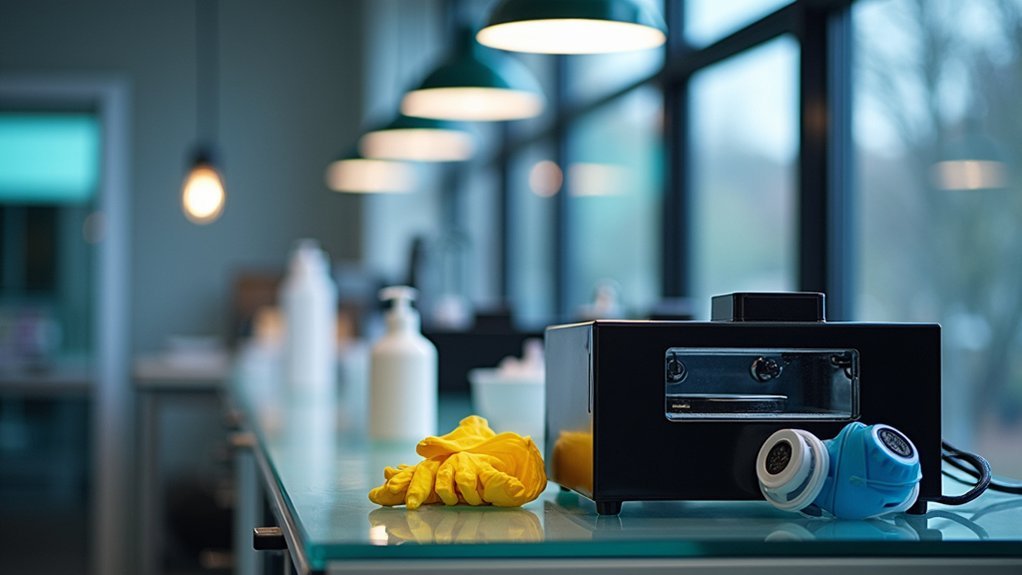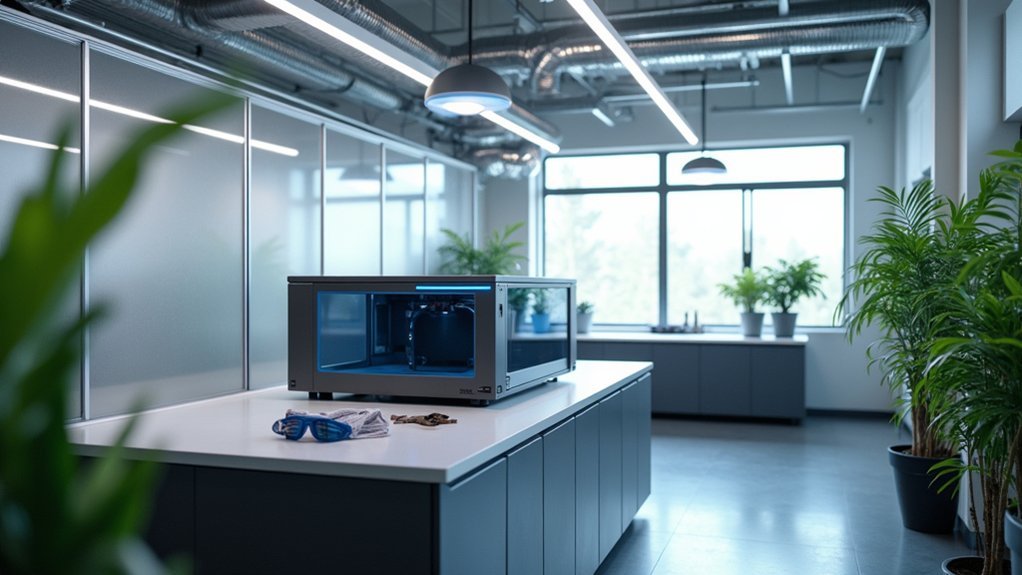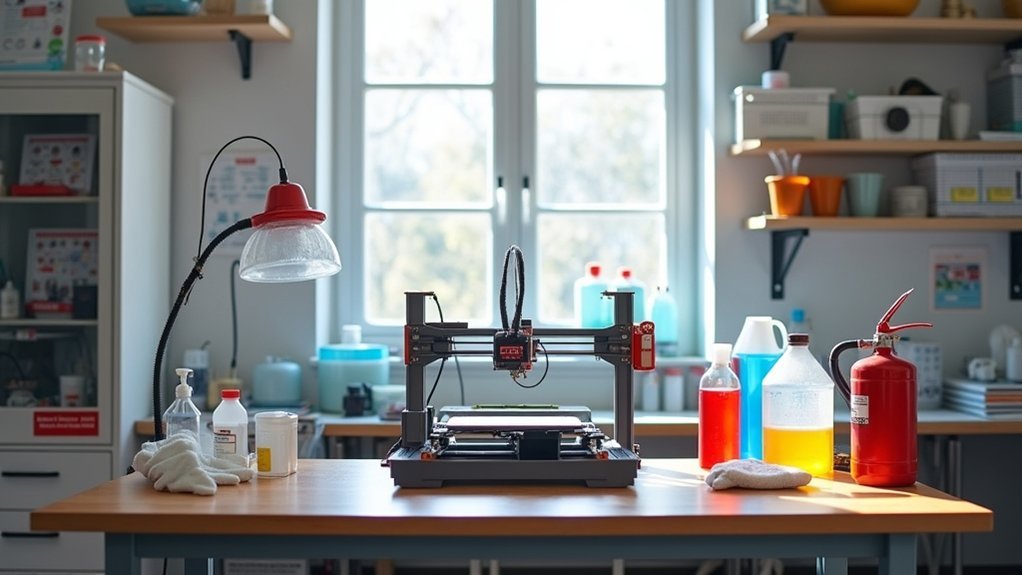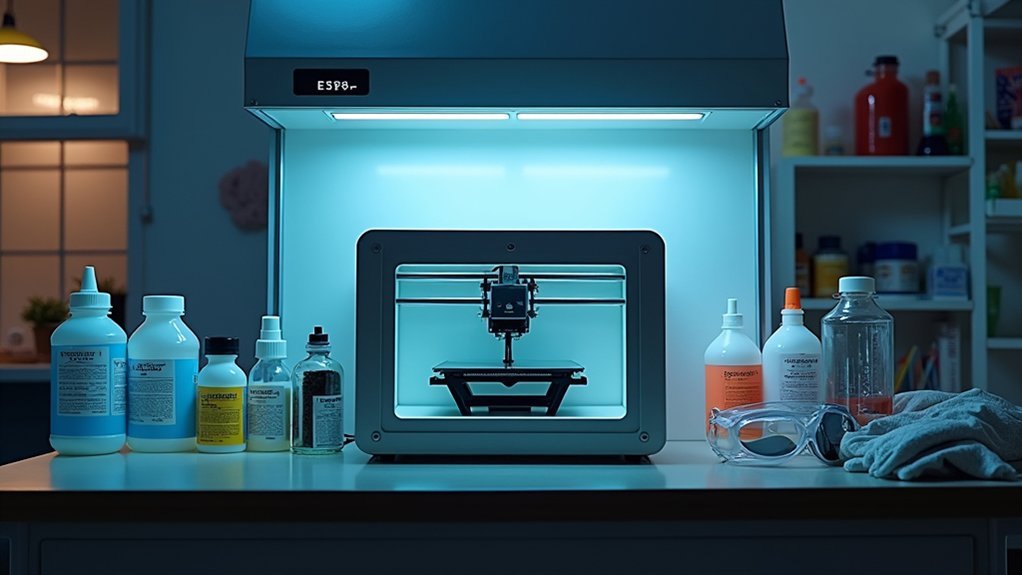You’ll need to establish five critical safety systems for your resin printing workspace. Start with proper PPE including VOC-filtered respirators, chemical-resistant nitrile gloves, and UV-protection eyewear. Design your workspace with chemical-resistant surfaces and implement zoning for different activities. Install ventilation systems providing at least 6 air changes per hour with HEPA and carbon filters. Store resins in UV-resistant containers between 4-25°C in dark cabinets. Following these thorough protocols will guarantee your workspace operates safely and efficiently.
Essential Personal Protective Equipment for Resin Printing

Resin printing’s inherent health hazards demand extensive personal protective equipment to safeguard against chemical exposure and UV radiation.
You’ll need respirators with VOC filters to block volatile organic compounds – they’re more effective than standard masks, especially in poorly ventilated spaces. Replace filters regularly per manufacturer guidelines to maintain protection.
Use chemical-resistant nitrile or neoprene gloves with extended cuffs, never latex. Inspect them before each use and replace if damaged. UV-cure contaminated gloves before disposal.
Chemical-resistant nitrile or neoprene gloves with extended cuffs provide essential protection – inspect before use and UV-cure before disposal.
Wear safety glasses with UV protection that fit snugly for full coverage. Consider goggles in high-splash environments.
Long-sleeved clothing and lab coats prevent skin exposure – avoid porous fabrics that absorb resin. Properly dispose of contaminated clothing to prevent ongoing exposure.
Install eye wash stations in easily accessible locations with clear marking for immediate response to accidental resin contact with eyes.
Optimal Workspace Design and Surface Selection
Beyond personal protection, creating an effective resin printing workspace requires strategic surface selection and layout planning that prioritizes both safety and operational efficiency.
You’ll need chemical-resistant surfaces like coated metal, glass, or high-density plastic laminates that withstand resin spills and isopropyl alcohol exposure. Avoid untreated wood or fabric that absorbs resin.
Implement a zoning system separating printing, cleaning, curing, and storage areas to prevent cross-contamination.
Position your printer on a stable, level surface with non-porous materials for easy cleanup. Use replaceable cutting mats or silicone mats during post-processing to protect underlying surfaces.
Maintain ambient temperatures between 25–35°C and avoid direct sunlight. Ensure proper ventilation throughout your workspace to safely remove resin fumes and maintain air quality during the printing process.
Keep waste disposal bins and cleaning supplies nearby, ensuring surfaces allow secure equipment positioning to prevent accidents.
Ventilation Systems and Air Quality Management

While a well-designed workspace layout provides the foundation for safe resin printing, effective ventilation systems serve as your primary defense against hazardous chemical exposure. You’ll need at least 6 air changes per hour to dilute VOCs and prevent nausea, headaches, and respiratory issues. Install high static pressure fans like centrifugal or mixed-flow models positioned to create negative pressure that pulls fresh air through your workspace.
| Component | Recommendation |
|---|---|
| Air Changes | Minimum 6 per hour |
| Fan Type | Centrifugal/mixed-flow (>20 watts) |
| Filtration | HEPA + activated carbon |
| Monitoring | Real-time VOC/particle sensors |
Supplement ventilation with HEPA and activated carbon filters to capture ultrafine particles and adsorb VOCs. Don’t rely solely on ventilation—combine it with proper PPE for thorough protection. Regular air quality monitoring helps ensure your ventilation system maintains safe pollutant levels and prevents dangerous accumulation of harmful substances.
Proper Resin Storage and Handling Protocols
Once your ventilation system is in place, establishing proper storage and handling protocols becomes critical for maintaining both resin quality and workspace safety.
Store your resins between 4°C and 25°C in opaque, UV-resistant containers with tight seals. Keep them in a dark cabinet away from heat sources and flames. Don’t fill containers completely—leave headspace to prevent gelling and pressure buildup.
Always wear nitrile or neoprene gloves with extended cuffs and safety goggles when handling resin. Never mix different resin types or pour used resin back into fresh bottles.
Label containers with dates and batch information for quality control. Before disposal, cure all waste resin completely using UV light or sunlight, then follow local hazardous waste regulations. If you encounter persistent problems with equipment or procedures, contact support from your resin printer manufacturer for technical guidance.
Emergency Response and Long-Term Safety Maintenance

Even with the best preventive measures, emergencies can occur in resin printing environments, making a thorough emergency response plan essential for protecting yourself and others.
Despite thorough prevention efforts, resin printing emergencies remain possible, requiring comprehensive response plans to safeguard everyone involved.
If you notice fire, smoke, chemical spills, or resin exposure, immediately cease printing operations and evacuate following marked routes. Call emergency services from a safe location and provide responders with Safety Data Sheets for involved chemicals.
For long-term safety, conduct routine inspections of ventilation systems, filters, and UV shielding. Monitor air quality for VOCs and schedule regular printer maintenance to prevent overheating or leaks.
Keep safety equipment like eye wash stations and fire extinguishers in working order. Train all operators in hazard recognition, emergency procedures, and PPE use while establishing incident reporting systems to continuously improve safety protocols. Prioritize safety over equipment in any emergency situation to ensure the protection of personnel above material concerns.
Frequently Asked Questions
Can I Use a Resin Printer in My Apartment Bedroom Safely?
You shouldn’t use a resin printer in your bedroom. Resin fumes pose health risks and can contaminate your living space. Choose a dedicated, well-ventilated room with windows instead.
How Much Does It Cost to Set up Proper Ventilation?
You’ll spend around $200 for basic ventilation setups with fans and ducting. Higher-end systems with filtration cost $300-$500, while industrial-grade purifiers exceed $1,000. Don’t forget ongoing filter replacement costs.
Are Water-Washable Resins Actually Safer Than Standard Resins?
Water-washable resins aren’t markedly safer than standard resins. You’ll still need full PPE since they’re sensitizers. They eliminate IPA handling risks but create contaminated wastewater disposal challenges instead.
What Should I Do if My Child Accidentally Touches Uncured Resin?
Immediately rinse your child’s skin with plenty of water and mild soap. Don’t scrub harshly. Remove contaminated clothing. Monitor for irritation or rashes, and seek medical attention if symptoms develop or worsen.
Can I Print Jewelry or Toys That Will Contact Skin?
You can print jewelry or toys for skin contact, but you’ll need biocompatible resins, complete curing, thorough rinsing, and proper testing to guarantee they’re safe before use.





Leave a Reply